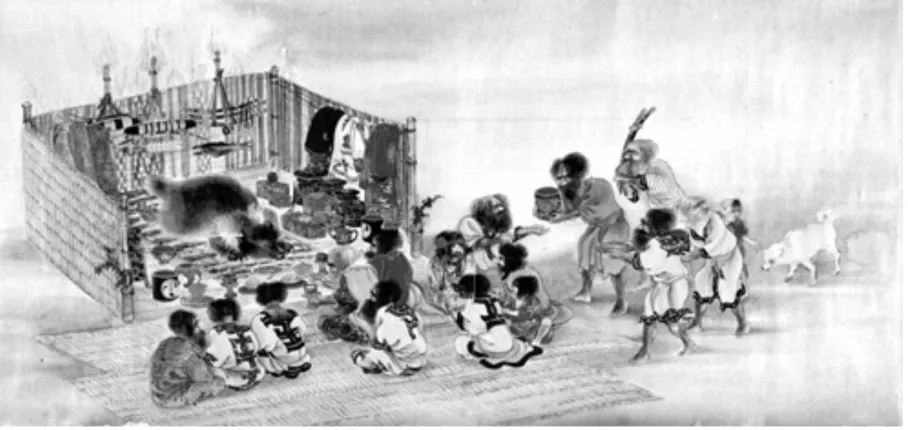A COMPARISON BETWEEN
SATOYAMA
AND THE
AINU
WAY OF LIFE
Devon Dublin
and
Noriyuki Tanaka
Graduate School of Environmental ScienceHokkaido University, Hokkaido Japan Email: devdub@ees.hokudai.ac.jp
ABSTRAK
Tulisan ini membandingkan konsep Satoyama dengan Ainu, dengan sudut pandang membangun kesamaan budaya, ekologi, dan ekonomis antara mereka dan untuk menguji dampak dari perkembangan Hokkaido pada ekologi manusia Ainu. Penelitian dilakukan di Semenanjung Noto, dan wilayah Hidaka dari Hokkaido. Data dikumpulkan melalui wawancara individu, rumah tangga dan kelompok, survei kuesioner, kunjungan lapangan, dan dokumentasi yang tersedia. Hasil penelitian menunjukkan praktek-praktek pertanian, ekologi, dan budaya-spiritual yang identik untuk Satoyama dan Ainu. Kajian menunjukkan bahwa perkembangan Hokkaido menghasilkan peningkatan yang diperlukan dalam pertanian di masyarakat Ainu karena itu tidak mungkin lagi untuk hidup berkelanjutan hampir seluruhnya dari karunia alam; yang berlaku untuk masyarakat adat secara global. Kami mengandaikan bahwa kesamaan ini memberikan titik masuk yang layak untuk promosi Satoyama jika akan digunakan sebagai model perkembangan untuk mempromosikan pengenalan praktek pertanian baru, efektif, dan berkelanjutan yang disesuaikan dengan budaya lokal dan pengetahuan tradisional yang ada. Sehingga pembangunan dilihat dari sudut komunitas adat yang berkelanjutan secara global jarang terjadi karena sistem modern dipraktekkan saat ini cermin begitu erat budaya asli tradisional.
Kata Kunci: Satoyama; Ainu; Pertanian; Ekologi; Bentang Alam.
ABSTRACT
This study compares the concept of Satoyama with that of the Ainu, with a view of establishing the cultural, ecological and economical similarities between them and to examine the impact of the development of Hokkaido on the Ainu human ecology. Research was conducted in the Noto Peninsula, and the Hidaka region of Hokkaido. Data was collected through individual, household and group interviews,
questionnaire surveys, ield visits and available documentation. Results revealed agricultural, ecological
and cultural-spiritual practices that were synonymous to Satoyama and that of the Ainu. Research showed that the development of Hokkaido resulted in a necessary increase in agriculture in the Ainu communities since it was no longer possible to live sustainably almost entirely from the gifts of nature; which holds true for indigenous peoples globally. We posit that these commonalities provide a viable entry point for the promotion of Satoyama if it is to be used as a developmental model for promoting the introduction of new, effective and sustainable agricultural practices that are tailored to suit the local culture and existing traditional knowledge, with a view of building sustainable indigenous communities globally, since it is infrequent that modern systems practiced today mirror so closely traditional indigenous culture.
INTRODUCTION
Satoyama is a term for landscapes that comprise a mosaic of different ecosystems which include forests, agricultural lands, grassland irrigation ponds and human settle-ments aimed at promoting viable human na-ture interaction (Duraiappah and Nakamura, 2012). When one considers the landscape of the archipelago of Japan, one would encoun-ter striking similarities between the various islands. Therefore, any community irrespec-tive of their location may have developed similar relationships with their natural sur-roundings. Research conducted so far with respect to the Ainu points to a differing way of life to that of the Japanese. But were they that different? This paper seeks to answer this question with respect to the Ainu, and whether there were similar tendencies be-tween their way of life during the Edo period (1615-1868), and that of the originators of Sa-toyama in the mainland of Japan in the 1800s and which was subsequently introduced into Hokkaido.
During Japan’s long and rich history, its landscape has transformed signiicantly and at one time did not include what is now known today as Hokkaido (Enomoto and Kimi, 1990). Shakushain an Ainu leader
man-aged to ight against the conquest of the is -land in an attempt to keep it in Ainu hands but the Tokugawa Shogunate managed to
inally solidify the Japanese presence on the
island (Walker, 2001).
According to Walker (2001),Shakushain warned the Ainu that if Ezo was subjugated, the shogunate would introduce peasants to Wajinchi and encourage the development of
agriculture, isheries and organized hunting.
In other words, he was adverting that the sys-tem to be introduced by the Japanese would be of a different perspective to that of the Ainu but was he correct? The Meiji regime, among other things, banned the Ainu from hunting in their ancestral hunting-grounds and imposing
ishing restrictions. In 1899, the Law for the
Protection of Former Hokkaido Aborigines was enacted which resulted in them becom-ing mainly small farmers (Howell, 1994).
Currently, the Hidaka region of Hokkai-do, Japan which covers 4,811.91km2, houses approximately 37.7% of persons of Ainu de-scent in Japan, the highest in any given area based on a 1999 census (Figure 1). The Hi-daka Mountains are known as a “Mecca of Mountaineering”, with more than 20 moun-tains including Mount Poroshiri at 2,052 me-tres (6,732 ft). These mountains are part of the Hidaka Sanmyaku-Erimo Quasi-Nation-al Park, which include Mount Apoi Quasi-Nation-alpine vegetation community and Cape Erimo coast landscape. These areas boast wildlife such as brown bear, sika deer, and common seal.
When the Hokkaido Development Com-mission was established in 1869, the human population was 58,000. In the initial phase of the development program, emigrants har-vested large quantities of construction tim-ber, developed new agricultural land, and
gathered a massive amount of irewood and
charcoal in preparation for the severe winter through clearing the forests on the outskirts of their residential area. From the 1880s on-wards, the rapidly increasing numbers of emigrants caused an increase in timber har-vesting (Aikoh et al., 2012). Wetlands along
the rivers were illed or dried to expand the
agricultural land base. Rivers were straight-ened and their banks cemented to protect
new paddy ields along the lowlands from erosion and looding (Ono, 1999).
As the agricultural development ex-panded and the almost total extinction of the deer population, the Ezo wolf (Canis lupus hattai) became a problem. Their usual prey, the deer had disappeared and as a result they attacked the farm animals resulting in boun-ty hunting supported by the Meiji govern-ment and massive poisoning by strychnine recommended by Edwin Dun. The last wolf was killed in 1896 (Walker, 2004). So devel-opment altered the ecosystem drastically, in contrast to the Ainu, who saw wildlife and
Figure 1. Map of Ainu in Hokkaido [1999] (Source: Platon, 2013)
The development and modernization
of Hokkaido included the Japanese govern-ment’s agricultural resettlement policy which transformed the Ainu’s traditional way of life. However, after the harvesting of vast quantities of timber for construc-tion, clearing of forested areas for agricul-tural land, and the use of large quantities of
irewood and charcoal especially during the
winter, a movement for the protection of the natural resources of Hokkaido evolved. This resulted in the development of the Satoyama of Hokkaido (Aiko et al., 2012). Although not considered as typical satoyama landscapes as witnessed in Honshu, the land management system practiced in the initial development
phase provided many key ecosystem ser-vices. A movement to protect Hokkaido’s natural resources emerged and the natural capital remains in abundance even today when compared with Honshu. The climate, topography, history and the rapid develop-ment in Hokkaido produced a very different landscape to the mosaic structure seen com-monly in Honshu. In Hokkaido, the term sa-toyama is used in the wider sense to refer to the forests which are close to living areas in
addition to natural and artiicial forests Ai -koh et al. (2012).
study. This article begins by comparing the Ainu with the Satoyama of Suzu in the Noto Peninsula from the perspective of landscape use. We then make a comparison on the basis
of the use of the ecosystem beneits derived
from the human nature interaction. A com-parison is then made from a cultural spiritual perspective.
The study of the Ainu was conducted in Samani town located in the Hidaka region of Hokkaido, Japan (Figure 2). It has an area of 364.33 km2 and a current population of 5,029 as of March 31st, 2012 (Japan Autonomous Academy, 2012). It was chosen because of the high percentage of persons of Ainu descent that currently live there.
The study of Satoyama was
conduct-ed in the city of Suzu locatconduct-ed in the Noto
peninsula of Ishikawa Prefecture, Japan (Figure 3). It covers 1,866km2 and homes approximately 189,000 households. This location was selected because it is one of the areas in which the Satoyama way of life developed. This area houses the Satoyama
Satoumi office that is staffed and works in
conjunction with the Kanazawa Universi -ty. The area is also famous for the Senmai-da, an area that conducts rice cultivation on terraced slopes and the community re-ceived accreditation as a Globally Impor-tant Agricultural Heritage Site (GIAHS) in June 2011.
Figure 3. Location of Suzu City
Data was collected in October and No-vember, 2012; February and March, 2013; May, 2013; and July to September, 2013 in the study site of the Hidaka region. Data was col-lected in January and February 2013 in the
study site of Suzu. Field trips were made to 48
sites of interest, 12 cultural activities were at-tended. Available documentations and
litera-ture were analyzed to determine the historical
land use of the Satoyama and Ainu while the interviews were conducted to capture the re-cent transitions and modern lands use.
Interviews
In the Hidaka region, key informant in-terviews were conducted with 27 community
members who were identiied collaboratively
with the Samani Town government and the Hokkaido University Center for Ainu Studies. Participation was voluntary. A total of four household interviews where all family mem-bers of the home participated and nine group interviews with a minimum of two persons were conducted (Table 1). Interviews were conducted in Japanese and translated into English with the help of an interpreter.
In Suzu, key informant interviews were
conducted with eight community members
who were identiied collaboratively with the
Noto Satoyama Satoumi ofice. By these means, we aimed to reduce participant self-selection
with regard to prior knowledge speciically
related to Satoyama. Participation was never-theless voluntary. A total of four household interviews where all family members of the home participated were conducted (Table 1). Interviews were conducted in Japanese and translated into English with the help of an in-terpreter.
We used a qualitative analysis approach where the aim was not to produce quantita-tive data and test hypotheses in a strict sense but to explore phenomena in depth. Ground-ed theory (Strauss and Corbin, 1998) was
em-ployed to analyze the qualitative data. All
interviews were digitally recorded and sub-sequently verbatim transcribed and checked. The categories and sub-categories were
iden-tiied for both Satoyama and Ainu. The inal main coding categories included landscape, ecology and cultural-religious practices.
DISCUSSION
Landscape Use
The description of the structure of the ko-tan (Ainu village) obtained from interviewees coincided with that presented by Watanabe (1973)and is illustrated in Figure 4. The typi-cal kotan was found to be strikingly similar to that of the Satoyama landscape (Figure 5) with areas such as the forest, mountain, river,
coast and latland having speciic purposes
and uses for their livelihood. Various
activi-ties such as agriculture, hunting, ishing and
scavenging are practiced in both communi-ties, providing a diet that consists of both gifts of nature and cultured crops.
Rules that were designed to be respect-ed and observrespect-ed by all, point to the sus-tainable use of natural resources within the scope of the carrying capacity. In the city
of Suzu, residents indicated that the area is
divided vertically from the mountains to the sea into various portions. Persons
liv-ing within their speciic portion are allowed
to collect edible plants, wood, seaweed and such like but are not allowed to venture into another portion that does not belong
Table 1 Interview Participants: Characteristics
Proile Characteristic Number of Participants
Suzu (n=21) Hidaka (n=66) Total
Gender Male 11 52 63
Female 10 14 24
Age range 18-39 6 12 18
40-59 7 39 46
to their area of residence. These rules are unspoken in nature and no one in particu-lar enforces them. As Dublin and Tanaka
(2014) points out, citizens consciously re -spect them and do not violate this princi-ple.
This principle occurred in Hokkaido as well, where the various kotans were as-signed vertical portions of land thus guar-anteeing them access to both hunting and
ishing grounds. These divisions were done
based on the availability of deer, salmon and certain key plants. This principle of carrying capacity was essential in preventing
over-ishing and overhunting. Whenever a kotan was considered too large due to an increase
in family size, they would make a decision
to divide themselves into two different ko-tans. A map showing the location of the vari-ous Ainu communities prior to the arrival of the Japanese which was seen in the Samani Museum, illustrates this reality (Figure6).
It must be noted that oftentimes vari-ous kotans would come together for
hunt-ing and ishhunt-ing expeditions. Permission to hunt, ish or gather in the iwor (territory) of another kotan could be sought and obtained from the village head. The village head would conduct a special ceremony to grant this person permission. This is important because the permission to exploit an area also carried a religious aspect. Any viola-tion of the iwor of another kotan was con-sidered a serious offence and could even carry the death penalty. Anyone who ven-tured into the iwor of another kotan did so at great personal risk. This is because traps are usually set to catch animals and ventur-ing into an area where the location of such traps is unknown is extremely dangerous. When permission is granted by the village head, the location of all traps is revealed to the individual.
Watanabe (1973) explains that ethnolo-gists have reconstructed the Ainu society as one that was centered on the river systems of inland Hokkaido, in which communities of a few households co-operated in subsistence
such as salmon-ishing, deer and bear hunt -ing and the gather-ing of edible plants.
Figure 4. Ainu village (After Watanabe, 1973).
Zone 1: River and tributaries (ishing);
Zone 2: River banks (plant collecting and cul-tivation); Zone 3: River terraces (deer hunt-ing in autumn, plant collecthunt-ing and habita-tion); Zone 4: Hillsides along the river course (deer hunting in early winter and spring and occasional and subsidiary bear); Zone 5: Riv-erhead mountain region (periodic and inten-sive bear hunting and collection of elm bark). As Sasaki (2009) points out, there are similarities observed in hunting activities, techniques, equipment, manners, land use, beliefs and world view among peoples in Japan. If one focuses on the ecosystem, then similarities and differences in natural
condi-tions such as lora, fauna, climate and
land-scape would inluence the hunting methods
The Ainu caught trout in the summer and salmon in the autumn. Spears were used to catch them individually, damming the river was done and then conical basket traps made of bamboo or twigs of willows were used to catch them. Each kotan or individual
had a speciic river ishing territory. In ad
-dition, sea ishing was done in 3 to 4 meter
Figure 5. A Transect Schematic representation of satoyama and satoyama landscape (After Yamamoto, 2001)
long boats and swordish, tuna, sunish and
marine mammals such as seals, dolphins and whales were caught. What is an important similarity between the Ainu and Satoyama
communities is the fact that ishing rights and zones were in place and there were es
-tablished ishing seasons(Fitzhugh and Du -breuil, 1999).
Again, just like ishing, the Ainu had a hunting period which extended from late autumn to early summer and a village pos-sessed a hunting ground of its own or seve-ral villages used a joint hunting territory. Heavy penalties were imposed on any out-siders trespassing on such hunting grounds or joint hunting territory. The Ainu hunted bear, Ezo deer, rabbit, fox and raccoon dogs among other animals. They also hunted sea eagles such as white-tailed sea eagles, ravens and other birds. The Ainu hunted with ar-rows and spears whose points were coated with poison. Traps were also used (Poisson, 2002; Deriha, 2009). Satoyama has mirrored the lifestyles of the Ainu and similar groups. If one were to examine saruyama(the hunt-ing of animals and birds that damage crops, and hare hunting in January and February); sunoyama (communal hunting that targeted the Japanese serow (Capricornis crispus) by Matagi hunters); tateshi (two or three hunt-ers capture a bear sleeping in its den); mura-tate (communal hunt like sunoyama but with community rules); and denjishsi (no commu-nity rules, only participants in the hunt were
beneiciaries); one would see a striking simi -larity between the Japanese hunting villages and the hunting practiced by the Ainu.
In the Satoyamas, the layout and land use in the traditional satoyama is quite similar to that of the Ainu and is closely related to the
utilization of surrounding areas. Fallen leaves
and underbrush in the forest was converted
to compost and returned to the crop ields, irewood and charcoal used for household
fuel; mushrooms and vegetables collected for human consumption from the forest (Saito et al. (2012). The gathering of edible plants by Japanese societies close to the forests called zenmai-yama(gathering of edible wild plants in the mountains and in particular royal fern (Osmunda japonica) mirrors that of the Ainu. In the case of the Ainu, women, children, and elderly men incapable of hunting were in-volved in this activity (Figure 7).
In the Satoyama, agriculture was a pivo-tal component of the entire system while in
the Ainu culture it was more subsistence in
nature which followed hunting, ishing and
collection of edible plants in terms of impor-tance. Notwithstanding, agriculture was an integral part of the Ainu ecosystem and as can be seen in Fig 4, the same area selected for farming was the identical location pre-ferred in the Satoyama system.
Historical evidence has shown that lim-ited farming was practiced by the Ainu in the southern parts of Hokkaido during the Edo period (1615-1868) as a means of supplement-ing their diet. In the late nineteenth and early twentieth century however, farming became fully established when these foods became staples (Kohara, 1999).
Figure 7. Ainu women involved in the collection of Heartleaf lily [Lilium cordatum]
(Credits: Hakodate Central Library). Note: Original Japanese caption removed
There were essentially two types of farm-ing. Dog farming was done for hunting, sled hauling, companionship, and food. Shifting cultivation was mainly undertaken by wom-en. For cultivation, the Ainu selected land with fewer grasses and trees demonstrating an avoidance of clearing vegetation and tree felling and they frequently selected riverside
land. They never fertilized the ields because
of their religious attitudes to their gods, nor
did they actively weed them (Morris- Suzuki,
Cosmological Views of Nature
The Ainu way of life was characterized by an inseparable and complex spiritual re-lationship with the land and phenomena of the natural world. Without a doubt, the Ainu regarded the ground in which they lived as sacred. Their beliefs were animistic in nature deeming every physical object to contain a spiritual being whether good or bad (Sugi-moto, 2010). The Japanese religious beliefs also present nature as sacred and advocates its reverence and conservation. Shintoism is fairly similar to the Ainu in this regard. The word Shinto (“way of the gods”) was adopt-ed, originally as Shindo,meaning “spirit” or kami; and refers to the divinity, or sacred es-sence, that manifests in multiple forms: rocks, trees, rivers, animals and places. The kami re-side in all things (Yamakage, et al., 2006).
The Ainu saw their hunting, ishing and plant gathering as reciprocal in nature. For example, an animal that was hunted actually wanted to be killed and was seen as a
spiri-tual act to legitimize their place in the natural
landscape (Walker, 2001). In other words, it was an integration of Ainu, animals and their kamuy (gods, spirits, deities). The Ainu’s view of nature as a willing participant in its inter-action with man is strikingly similar to the Satoyama concept which views the
human-nature interaction as being mutually benei -cial thus creating interdependence on both worlds.
Ainu philosophy frowns on wastage, a stark reminder of the Japanese concept of Mottaini, and everything that is collected is supposed to be used meaningfully, if not, the deity in the object cannot return to the world of deities and this will bring suffering to the humans because there will be a lack in the fu-ture (Nakamoto, 2004). The maximum
uti-lization of resources is an important compo -nent of Satoyama.
Ritual Reactions to Nature
Animals were considered kamuy and when killed, liberated spirits, and cemented sacred ties to the land. Special rituals were conducted to commemorate and celebrate anything that was taken from the natural en-vironment. While communities shared kin-ship ties and sometimes for access to hunt-ing territories (iwor), the central focus of that unity was the bear ritual (iyomante) as shown in Figure 8 (Peng and Geiser, 1977). Often-times, bear cubs were caught and reared in special cages for this festival underscoring the importance of this festival when one
con-siders the quantity of ish that involved for
feeding them.
Results revealed that these Ainu prac-tices and customs were synonymous to those found in Satoyama areas. The agricultural fes-tival of Noto called Aenokoto where the “God
of the Rice ields” is accommodated into the
homes of residents during the winter and wished farewell in the spring to participate in and give success in the annual rice planting and harvesting was found to be similar to the philosophy of the Ainu of Hokkaido where the kamuy of plants and animals in nature are welcomed when harvested or killed respec-tively and bid farewell in a Kamuy ceremony.
Aenokoto is an agricultural ritual
recog-nized by UNESCO as an intangible folk cul -tural asset where, in December after the rice harvest, the master of the house welcomes the deity of the rice paddies into the house accompanied by feasting and thankful of-ferings. In February, the ritual is
repeat-ed to send the deity into the ields to bless
and prosper the harvest in the New Year. Because the deity is said to have poor eye-sight, it is guided carefully and with lots of respect (Research Institute of City Planning and Communication, 2010). This ritual fur-ther reinforces the strong socio-cultural bond between the people and agriculture. Dublin and Tanaka (2014) further pointed out that tombs which were observed in family owned
rice ields was indicative and symbolic of the
continued support by the ancestors in the an-nual cultivation of rice. This can also be ob-served in China as well as in Vietnam (Zeng,
2010). Similarly, in the area of ishing, it was
no different. The Ainu celebrated the festival of Asircep-Nomi for the salmon harvest. The Tomobata festival to pay homage to the gods
of the sea and for the safety of ishermen is
celebrated in Noto city.
CONCLUSIONS
The study demonstrates that the major difference between Satoyama and the Ainu was the importance placed on agriculture which was on a low scale in the latter due to their traditional and somewhat nomadic life-style. The development of Hokkaido resulted in a necessary increase in agriculture in the
Ainu communities since it was no longer pos-sible to live sustainably almost entirely from the gifts of nature. This is important because the same holds true for indigenous peoples globally which often requires drastic changes in their traditional agricultural practices to accommodate new and improved techniques which best guarantees their food supply and survival.
We posit that these commonalities pro-vide a viable entry point for the promotion of Satoyama if it is to be used as a develop-mental model for promoting the introduction of new, effective and sustainable agricultural practices that are tailored to suit the local cul-ture and existing traditional knowledge, with a view of building sustainable indigenous communities globally, since it is infrequent that modern systems practiced today mirror so closely traditional indigenous culture.
A popular view of Ainu culture is of a people living with nature in a pre-industri-al environment, a culture admired as a lost ideal. We posit that Satoyama-Satoumi was the Japanese return to that lost ideal in the case of Hokkaido. In addition, lessons learnt from the development of Hokkaido shows that it is necessary to understand the way of life of the indigenous people in the area which we seek to develop, and facilitate development around their cosmological view of habitat and ritual reactions to it. As this study shows, there are always desirable similarities to be
found which can be utilized as a foundation
on which any developmental model could be premised.
ACKNOWLEDGEMENT
funded this research as a part of the strategic program for fostering environmental leaders.
BIBLIOGRAPHY
Aikoh, T., Hamada, S., Hattori, K., Kaji,
K., Kazikawa, H., Kameyama, S.,
Kaneko, M., Kondo, T., Konno, Y., Mano, T., Matsushima, H., Morimoto, J. Osaki, M., Sajiki, T., Segawa, T., Shoji, A., Shoji, Y., Takayanagi, S., Tsuji, O., Yanagawa, H. and Y. Yoshida. 2012. Hokkaido Cluster, In Satoyama-Satoumi Ecosystems and Human Well-Being, Socio-Ecological Production Landscapes of Japan, edited by Duraiappah, A., K. Nakamura, of Small Animals in the Nineteenth-Century Fur Trade System, In Human Nature Relations and the Historical Backgrounds of Hunter-Gatherer Cultures in Northeast Asian Forests, edited by Sasaki, S., Senri Ethnological Studies 72: 101-115.
Dublin, D. and N. Tanaka. 2014. The Origin and Meaning of Satoyama: A
Peoples Perspective from citizens of Suzu City, Japan, International Multidisciplinary Research Foundation (IMRF), Ratna Prasad Multidisciplinary Research and Educational Society, Andhra Pradesh, India. Life Sciences International Research Journal 01 (01): 86-89. Duraiappah, A. and K. Nakamura. 2012. The
Japan Satoyama Satoumi Assessment: Objectives, focus and approach, In Satoyama-Satoumi Ecosystems and Human Well-Being, Socio-Ecological Production Landscapes of Japan, edited by Duraiappah, A., K. Nakamura, Studies Center, National Museum of Natural History, Smithsonian Institution, Washington, D.C. pp. 202-207.
Hokkaido Government. 2013. Hokkaido Regions and Cities, Available at: http://web-jpn.org/region/pref/hokkaido.html. Accessed on November 20, 2013. Howell, D. 1994. Ainu ethnicity and the
boundaries of the early modern Japanese state, Past and present 142: 69-93. Japan Autonomous Academy. 2012.
Hokkaido Municipalities, Shimokawa, Hokkaido, Japan. History, Smithsonian Institution, Washington, D.C.
Morris-Suzuki, T. 1994. Creating the frontier:
border, identity and history in Japan’s far north,EAH 7: 1-24.
Nakamoto, M. 2004. Rediscovering an Appreciation for Ainu Culture, In Circumpolar Ethnicity and Identity, edited by Irimoto, T. and T. Yamada, Senri Ethnological Studies 66: 3-5. Noto GIAHS Regional Executive Committee.
2011. Noto’s Satoyama and Satoumi - Life in Noto, Satoyama Creation
Ofice, Environment Department,
Ishikawa Prefectural Government, Japan.
History, Smithsonian Institution, Washington, D.C.
Ohnuki-Tierney, E. 1993. Rice as self: Japanese Identities Through Time, Princeton University Press, Princeton, New Jersey.
Platon, A. 2013. Map of Ainu in Hokkaido (1999), via Wikimedia Commons Available at: http://commons. wikimedia.org/wiki/File%3AMap_ of_Ainu_in_Hokkaido.svg. Accessed on November 20, 2013.
Poisson, B. 2002. First Peoples: The Ainu of Japan, Lerner Publications Company, Minneapolis. pp. 32-33.
Research Institute of City Planning and Communication. 2010. Traditional knowledge and wisdom of Satoyama/ Satoumi: charcoal and salt making traditions in Ishikawa, Syoseki
Company Limited, Kanazawa
University, Japan.
Saito, O., H. Shibata, K. Ichikawa, T. Nakamura, Y. Honda and J. Morimoto. 2012, Satoyama and satoumi, and ecosystem services: A conceptual framework, In Satoyama-Satoumi Ecosystems and Human Well-Being, Socio-Ecological Production Landscapes of Japan, edited by Duraiappah, A., K. Nakamura, K. Takeuchi, M. Watanabe and M. Nishi, pp. 265-281, United Nations University Press, Japan.
Sasaki, S. 2009. Human Nature Relations and the Historical Backgrounds of Hunter-Gatherer Cultures in
Northeast Asian Forests, Senri Ethnological Studies 72: 4-14.
Strauss, A. and J. Corbin. 1998. Basics of qualitative research: techniques and procedures for developing grounded theory, 2nd ed. edn, Sage, Thousand Oaks.
Sugimoto, Y. 2010. An introduction to Japanese society, pp. 209-211, Third Edition, Cambridge. Walker, B. 2001. The Conquest of Ainu Lands, Ecology and Culture in Japanese Expansion, 1590-1800, pp. 17-127, University of California Press, USA.
Walker, B. 2004. Meiji Modernization, Scientiic: Agriculture, and the
Destruction of Japan’s Hokkaidō
Wolf, Environmental History 9 (2): 248-274
Watanabe, H. 1973, The Ainu Ecosystem: Environment and Group Structure, University of Washington Press, Seattle
Yamakage, M., P. Leeuw and A. Rankin. 2006. The essence of Shinto: Japan’s spiritual heart. Tokyo: Kodansha International.
Yamamoto, S. 2001. Studies on the effect of changes in rural landscape structure on secondary forest plants in Japanese rural areas, Bulletin of the National Institute for Agro-environmental Sciences 20: 1-105 Zeng, X. 2010. Agricultural view of history
![Figure 1. Map of Ainu in Hokkaido [1999] (Source: Platon, 2013)](https://thumb-ap.123doks.com/thumbv2/123dok/861328.817609/3.595.71.526.99.494/figure-map-ainu-hokkaido-source-platon.webp)
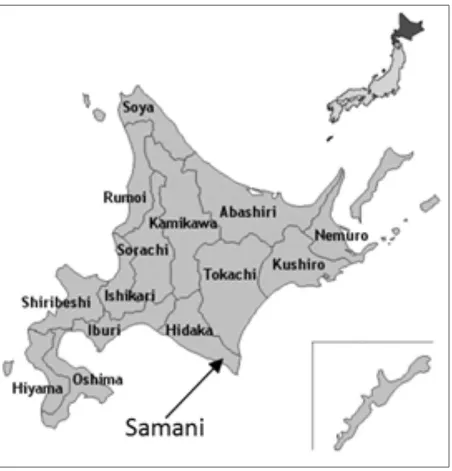
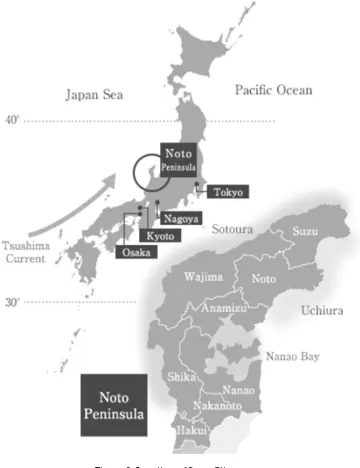

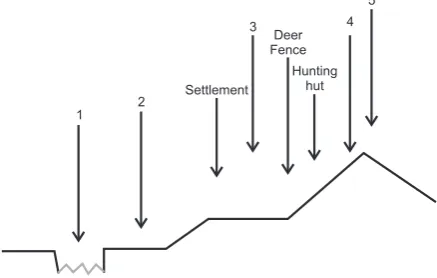
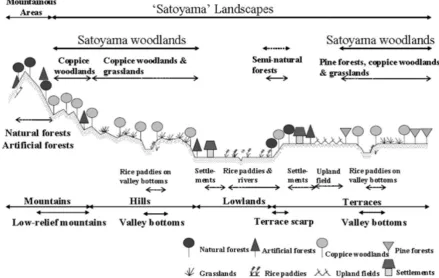
](https://thumb-ap.123doks.com/thumbv2/123dok/861328.817609/9.595.306.526.319.500/involved-collection-heartleaf-cordatum-credits-hakodate-central-library.webp)
